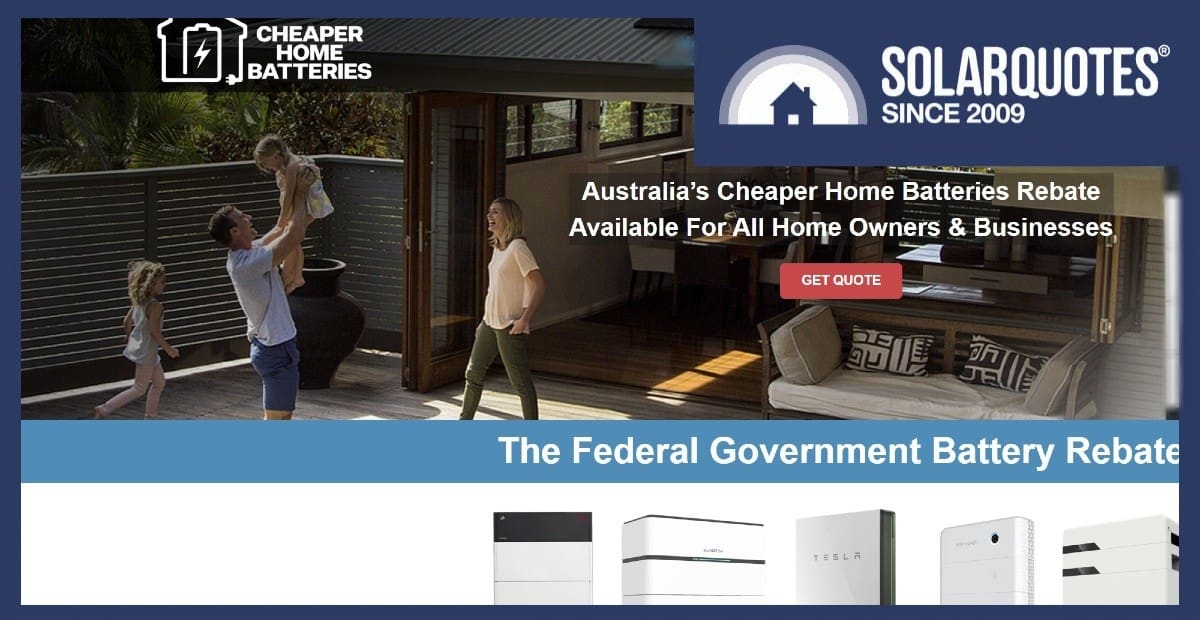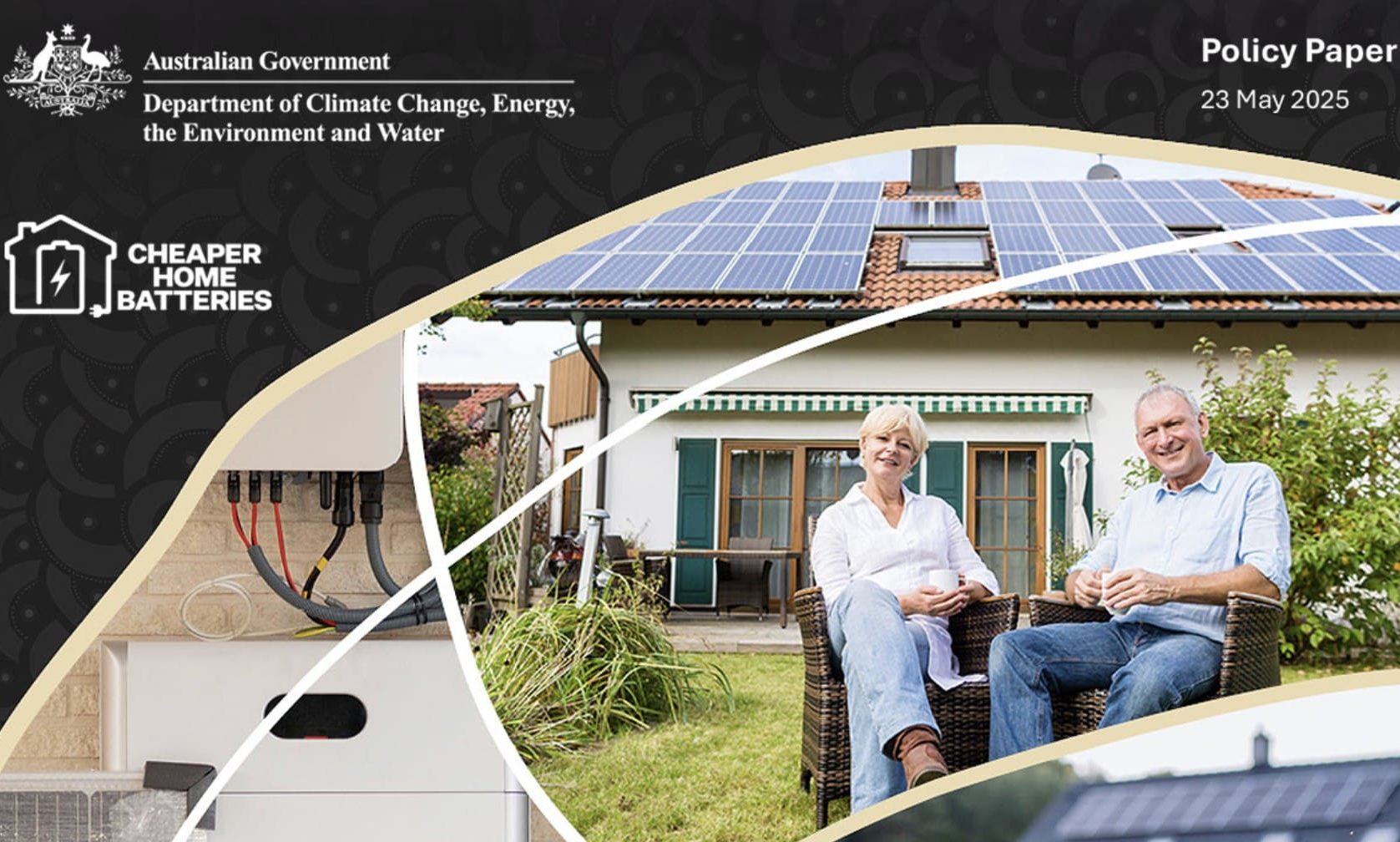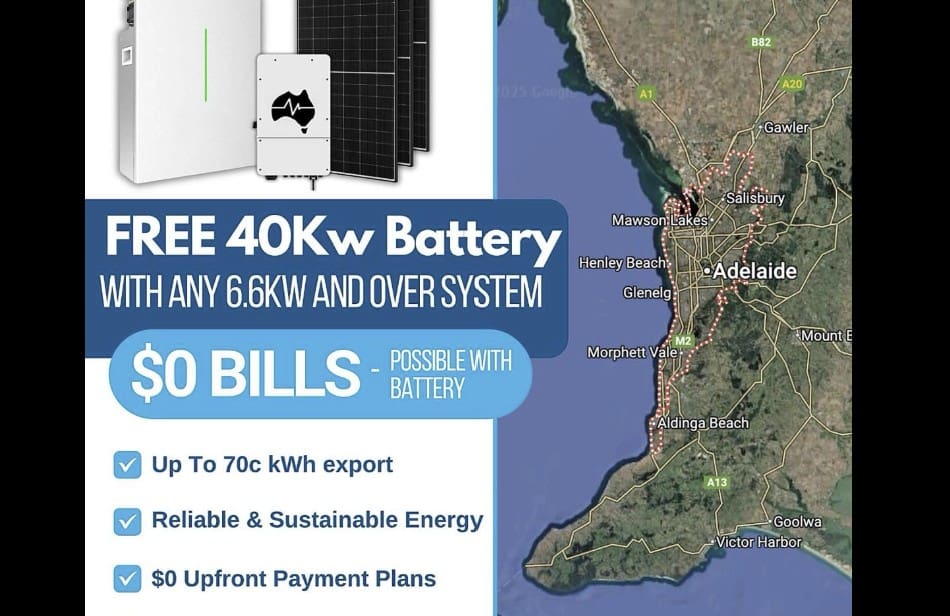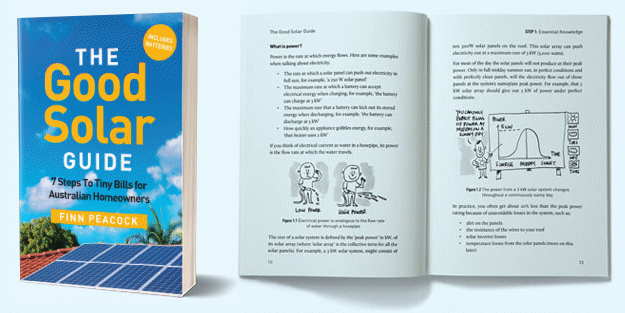
A Rebate Robber In Disguise
From all appearances, it is a helpful government explainer website. Bearing the Cheaper Home Batteries Program name, website address, logo, and selected key details on the scheme, the site encourages readers to get more information and a quote (as long as they provide their full name, phone number, energy consumption details as well as home and email address).
The telltale sign not all is what it seems? The email address is a “.com.au”, rather than a government “.gov.au”. There’s not a single word on the site indicating what company is actually behind the page.

The website even lifted an image from an official government policy document, complete with a departmental logo.
The Battery Rebate Isn’t Our First Rodeo
The federal battery incentive has triggered a stampede of suspect practices like these, and it is all a familiar sight to SolarQuotes founder Finn Peacock. Working in the renewable energy division of CSIRO in 2008, he saw unscrupulous types rush to take advantage of the federal solar rebate that had just launched.
“The rebate triggered an influx of dodgy operators who would whack 1kW of cheap, nasty panels on your roof paired with a rubbish inverter, charge $500 total and still make a profit,” he writes in a column for The Guardian published over the weekend.
The consequences were extremely serious: a NSW review in 2012 found around 18% of the solar installations it inspected had major defects, and a further 63% had minor ones. Other reports from the time found as many as 2000 homes around Australia were at risk of fire due to shoddy solar installations related to the government subsidy.
The shonky offers made Finn so mad that he launched SolarQuotes to try and offer homeowners a reliable information resource on solar, and access to reputable installers.
Finn says he’s already seen suspect offers circulating for the federal battery rebate, which launched July 1.
How To Avoid Getting Lassoed Into A Bad Deal
Finn advises people interested in getting a battery under the scheme to take the following steps:
- Choose well-known brands;
- Use a local installer with a decent track record;
- Read an installer’s 1-star reviews;
- Think about sizing: don’t go for a battery that is too small or big;
- Check your solar capacity is sufficient to fill your chosen battery;
- Reward good installers if you’ve had a positive experience in the past;
- Slow down. The rebate isn’t vanishing tomorrow;
- Check the fine print: in one example, Victoria-based company Amazing Solar advertises a solar system for “free” in caps lock text on a red label, but the fine print of the advertisement clarifies that it actually involves a loan from a state government that will need to be paid back.
Don’t Get Caught In The Stampede
Its not hard to imagine what’s next based on how the solar rebate unfolded. The Cheaper Home Batteries Program has been hitched to the same scheme that the solar incentive uses, and similarly it will go down by a small amount each year.
Years after the solar rebate launched, we still see ads warning consumers they are about to miss out on the solar rebate at the end of each year, exaggerating the fact that it drops a small amount each year. The analysis of SolarQuotes fact checker Ronald Brakels finds that the battery rebate will reduce at a slower pace than the solar scheme, and battery price declines are likely to largely offset that anyway.
As I warned in an interview last week with Choice: “if you see an advertisement for a solar product that warns you to act now before the rebate ends, they are misleading you.”
Make Sure To Dodge These Battery Bullets
There’s plenty of red flags to spot a suspect deal before you put your name on the dotted line:
- Beware any promises of “free” batteries or “free” solar: if it sounds too good to be true, it probably is;
- Watch out for companies that don’t seem to understand their own product – i.e. confusing a kilowatt hour with a kilowatt;
- Be on guard when a company isn’t transparent about who they say they are, i.e. pretending to be an official government source;
- Be careful with anyone promising the exact amount you’ll save under the rebate, which will vary depending on the specifics of your requirements (we even saw companies promote the rebate as officially locked in back when it was still an election promise);
- Take care if someone knocks on your door or cold-calls you to sell a battery – these sales practices are usually not a great sign and have triggered plenty of complaints.

The Solar Broker has stuffed an impressive number of red flags into the one advertisement, from confusing a kW with a kWh to promising a free battery.
Installers Need To Ride With The Right Crowd
SolarQuotes’ in-house installer Anthony Bennett says it shouldn’t just be consumers scanning the horizon for cowboys. In his latest article he argues that electricians need to do their part to avoid a race to the bottom.
Bennett notes that with the huge amount of work on offer, installers can afford to pick and choose which retailers they work with.
“Let the rubbish collapse under its own weight. Stand firm. Resist the temptation to soothe the hip pocket nerve with a short-lived bargain. If enough of us do, the worst operators will burn out,” he says.
For more on the federal battery rebate, read our regularly updated explainer, and to do your own homework on whether an installer or battery brand is reputable, check our reviews page.

 RSS - Posts
RSS - Posts



Yes, facebook is flooded with dodgy adds at the moment.
You are so correct so many dodgy companiers
Can’t the reportedly bloated public service spare a few bodies to monitor these ads and check out the advertisers and get them taken down
Unless the advertiser is quoting the max instaneous power ,doubtful, and not the battery’s capacity? Then yes agreed 40kw would be impressive .
But batteries do have two figures, output power ,and capacity ( kw and kWh which I’m sure you checked ?) so to assume can……….?
Hi Av E,
The point is that this crowd can’t even specify the system they’re selling correctly…
It reminds me of the scammers who could have brilliantly written letters of recommendation from well educated, verbose and inspiring Nigerian princes.
They are often littered with a few errors though.
Those who pick up on the mistakes are also likely to waste a scammers time or even cause problems by engaging in legal action.
So if they include some spelling mistakes and poor terminology then the scammers will have managed to filter their marks. The poorly educated will self select to be taken advantage of.
Maybe the solar broker just doesn’t know what he’s selling, besides cheap?
…we got a rough quote for a Sungrow battery last week by our original installers, which seemed like a great price …so they came out for an inspection this week (which is appreciated because we live an hour+ out of town) …then when they sent the offical quote it was $1.5k more …we called them & asked for some more clarity & they said “yeah sorry but the price of the Sungrow batteries has just gone up”…how do we know they are not making it up ?…they said something about current stock & future stock being low, which pushes the price up …I thought battery prices are steadily falling, not jumping by $1.5k in a week ???
🔆 Public Statement from Amazing Solar
We thank SolarQuotes for promoting transparency in solar. However, as the retailer named in their article, we must clarify our position and reaffirm our values of honesty, compliance, and customer focus.
The banner in question offered a 6.6 kW solar system with a 10 kWh battery, supported by a Solar Victoria interest-free loan of up to $1,400. The “free” label referred to this government-backed loan, not a giveaway. Full terms were clearly stated.
Unfortunately, SolarQuotes showed a cropped version of our banner, omitting key details and giving a misleading impression.
We pride ourselves on NETCC-approved sales, CEC (SAA) -accredited installations, tailored systems, no pressure tactics, and transparent pricing. We are not “rebate cowboys” and have 4.8+ star ratings.
We invite homeowners to contact us directly to learn the full story and judge us by our service and results.
– Amazing Solar Team
Solar install Contracts
This is the one key aspect that no one mentions or debates, including Finn Peacock of Solar Quotes.
Almost all the contracts I have read are onesided with no room for negotiation or additional safeguard for the customer . They all seem to have the same format and require to be signed online without alteration.
Many of them violate even the basic consumer protection rights of the customer and they have the gall to include a statement in the contract that states where any provision that is unenforceable under law would not invalidat any other part of the contact.
Some of the contracts make hilarious reading as the new batteries contacts are altered versions ,of their solar panel ontallation contacts and have clause of roof intergrity.
It is high time Finn Peacock or some Govt agency wrote out a template contact, with provisions to alter portions to suit individual installations.
I speak from years of dealing with various contractors and suppliers from work.